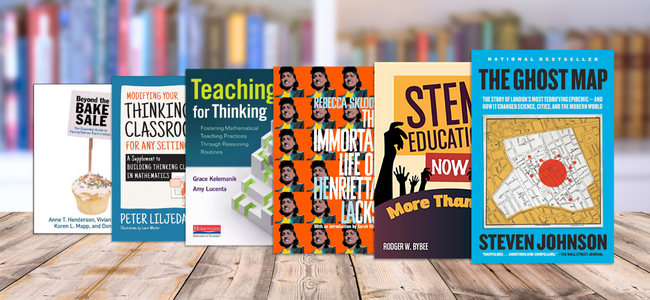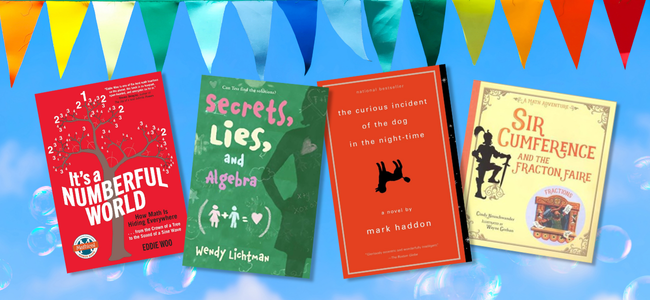A Prime Summer Reading List Math Teachers Will Absolutely Love
Posted 06/05/2024 by TI Staff and TI Teacher Community

School’s out for summer! That means it’s time to relax, recharge and find a good book to read. What are math and science teachers reading this year to combat summer brain rot? We asked you, our teacher community, for ideas.
This summer reading list features a hot mix of teaching practices, histories and mysteries for the math- and science-minded. The newest addition to our book list: math reads for students! And we’ve also included relatable stories for students that help encourage math (and reading) literacy.
The teacher community made these great recommendations to add to your summer reading list:
Books for math and science teachers:
- “Building Thinking Classrooms in Mathematics” and “Modifying Your Thinking Classroom for Different Settings”
- “Routines for Reasoning” and “Teaching for Thinking”
- “Beyond the Bake Sale”
- “STEM Education NOW”
- “The Immortal Life of Henrietta Lacks”
- “The Ghost Map”
Books for math students:
- “Sir Cumference Series”
- “It’s a Numberful World: How Math is Hiding Everywhere”
- “Secrets, Lies and Algebra”
- “The Curious Incident of the Dog in the Night-Time”
- Synchronous/asynchronous virtual and hybrid settings
- Fixed seating
- Small groups
- Tutoring
- Independent learning
- Homeschooling
- And more

Summer reading list for the math and science teachers

“Building Thinking Classrooms in Mathematics, Grades K–12: 14 Teaching Practices for Enhancing Learning”
by Peter Liljedal
“Modifying Your Thinking Classroom for Different Settings: A Supplement to Building Thinking Classrooms in Mathematics”
by Peter Liljedal

“Routines for Reasoning: Fostering the Mathematical Practices in All Students”
by Grace Kelemanik, Susan Janssen Creighton, Amy Lucenta
“Teaching for Thinking: Fostering Mathematical Teaching Practices Through Reasoning Routines”
by Grace Kelemanik, Amy Lucenta
Another powerful reading combo, “Routines for Reasoning” and “Teaching for Thinking” provide expert guidance on how to use routines as tools to build student reasoning and mathematical thinking skills. These books offer meaningful support on how to get started, how to incorporate routines into your classroom, and how it can lead students to independent thinking.
Authors Kelemanik and Lucenta also appear as guests on two episodes of the Room to Grow podcast. They share how the power of routines is helping teachers “hand over agency to students” and go on to explain that, “Teachers are no longer the sole authority in the classroom [...] it’s the students doing the heavy lifting.”

“Beyond the Bake Sale: The Essential Guide to Family/School Partnerships”
By Anne T. Henderson, Karen L. Mapp, Vivian R. Johnson, Don Davies
Studies have shown that students with parents active in their education at home receive higher grades and test scores. As an educator, if you’ve ever wondered, “How can we improve our parent interactions?” then be sure to pick up your copy of “Beyond the Bake Sale.”
Featuring tips from teachers, checklists and other valuable resources, this book offers practical advice on building strong collaborative relationships between teachers and parents.

“STEM Education NOW More Than Ever”
by Rodger Bybee
More than ever, science and math educators have been asked to incorporate STEM learning into their classrooms to prepare students to compete globally.
Veteran educator Rodger Bybee not only addresses the future of STEM education, but also provides practical advice for teachers, leaders and the STEM community. His book “STEM Education NOW More Than Ever” shares new approaches to STEM learning to complement traditional, single-discipline programs and highlights newer, faster ways to help teachers develop STEM units that address contemporary challenges in their classes.

“The Immortal Life of Henrietta Lacks”
by Rebecca Skloot
A true story investigation about the woman whose cells, only known to scientists as “HeLa,” became one of the most important tools in modern medicine. Taken without her knowledge, the “immortal” cells of Henrietta Lacks, a poor tobacco farmer, were used to help develop the polio vaccine and uncover secrets of cancer, viruses, and even the effects of atom bombs. They have been bought and sold by the billions, and yet, her children today cannot afford health insurance. A powerful story to provoke thoughtful conversations for students and teachers to discuss: “Just because we can, should we?”

“The Ghost Map: The Story of London's Most Terrifying Epidemic—and How It Changed Science, Cities, and the Modern World”
By Steven Johnson
In the summer of 1854, London was emerging as one of the first modern cities in the world, only to become the perfect breeding ground for a terrifying disease no one knew how to cure. In a triumph of multidisciplinary thinking, a physician and a local curate are spurred to action and ultimately solve the most pressing medical riddle of their time.
This book shares a riveting history and a powerful example as to why we need to be able to think and solve problems outside of the classroom.

Classroom books for math students

This year, we noticed teachers were also recommending books they share in their classroom with students. One teacher, Mrs. Barajas, also shared her classroom bookshelf of math-themed books for her middle schoolers.
Here are several recommendations for student math reading to make math concepts fun and relatable:

The “Sir Cumference” Series
by Cindy Neuschewander
This book series is absolutely perfect for middle school readers. They will follow Sir Cumference on terrific math adventures as he problem-solves situations like: The First Round Table, A Dragon of Pi, The Sword of the Cone, All the King's Tens, A Fraction Faire ... and many more!

“It’s a Numberful World: How Math is Hiding Everywhere”
by Eddie Woo
Students will love exploring patterns while secretly learning about math! These 26 chapters explore hidden mathematical patterns of the world in bite-sized chapters that are easy to digest and share with others.

“Secrets, Lies, and Algebra”
by Wendy Kichtman
Who knew the 8th grade would make life — and math — so complicated? Readers follow Tess as she navigates new social and math concepts, and the key principles that can help her handle life’s uncertainties.

“The Curious Incident of the Dog in the Night‑Time”
by Mark Haddon
A story of a young man who loves lists, patterns and truths, but hates the color yellow and being touched. He knows a lot of math, but little about human beings. Finding the neighbor’s dog murdered at the end of the road sets him onto a murder mystery like no other.

Share your summer reads with us!
We’d love to hear what books you read and recommend. Share and tag us on Instagram, Facebook or X (formerly known as Twitter) @TIcalculators and tell us all about your own summer reading list.
Want to find more ideas for promoting math in the classroom? Join our TI Teacher Community Facebook group and exchange ideas with teachers like you.
Tagcloud
Archive
- 2025
- 2024
-
2023
- January (3)
- February (3)
- March (5)
- April (3)
- May (3)
- June (3)
- July (2)
-
August (6)
- 5 Ways to Spruce Up Your Classroom for Back to School
- Day of the Dog: Which Dog Is Roundest?
- Women Who Code: A TI Intern’s Fascinating STEM Journey
- 6 Sensational TI Resources to Jump-Start Your School Year
- 3 Back-to-School Math Activities to Reenergize Your Students
- A New School Year — A New You(Tube)!
- September (2)
- October (3)
- November (1)
- 2022
-
2021
- January (2)
- February (3)
- March (5)
-
April (7)
- Top Tips for Tackling the SAT® with the TI-84 Plus CE
- Monday Night Calculus With Steve Kokoska and Tom Dick
- Which TI Calculator for the SAT® and Why?
- Top Tips From a Math Teacher for Taking the Online AP® Exam
- Celebrate National Robotics Week With Supervised Teardowns
- How To Use the TI-84 Plus Family of Graphing Calculators To Succeed on the ACT®
- AP® Statistics: 6 Math Functions You Must Know for the TI-84 Plus
- May (1)
- June (3)
- July (2)
- August (5)
- September (2)
-
October (4)
- Transformation Graphing — the Families of Functions Modular Video Series to the Rescue!
- Top 3 Halloween-Themed Classroom Activities
- In Honor of National Chemistry Week, 5 “Organic” Ways to Incorporate TI Technology Into Chemistry Class
- 5 Spook-tacular Ways to Bring the Halloween “Spirits” Into Your Classroom
- November (4)
- December (1)
-
2020
- January (2)
- February (1)
- March (3)
- April (1)
- May (2)
- July (1)
- August (2)
- September (3)
-
October (7)
- Tips for Teachers in the time of COVID-19
- Top 10 Features of TI-84 Plus for Taking the ACT®
- TI Codes Contest Winners Revealed
- Best of Chemistry Activities for the Fall Semester
- Best of Biology Activities for the Fall Semester
- Best of Physics Activities for the Fall Semester
- Best of Middle Grades Science Activities
- November (1)
- December (2)
- 2019
-
2018
- January (1)
- February (5)
- March (4)
- April (5)
- May (4)
- June (4)
- July (4)
- August (4)
- September (5)
-
October (9)
- Art in Chemistry
- Which Texas Instruments (TI) Calculator for the ACT® and Why?
- Meet TI Teacher of the Month: Jessica Kohout
- Innovation in Biology
- Learning With Your Students
- A first-of-its-kind STEM strategy charts path to help educators
- #NCTMregionals Hartford 2018 Recap
- The Math Behind “Going Viral”
- Real-World Applications of Chemistry
-
November (8)
- Testing Tips: Using Calculators on Class Assessments
- Girls in STEM: A Personal Perspective
- 5 Teachers You Should Be Following on Instagram Right Now
- Meet TI Teacher of the Month: Katie England
- End-of-Marking Period Feedback Is a Two-Way Street
- #NCTMregionals Kansas City 2018 Recap
- Slope: It Shouldn’t Just Be a Formula
- Hit a high note exploring the math behind music
- December (5)
- 2017
- 2016
- 2015
